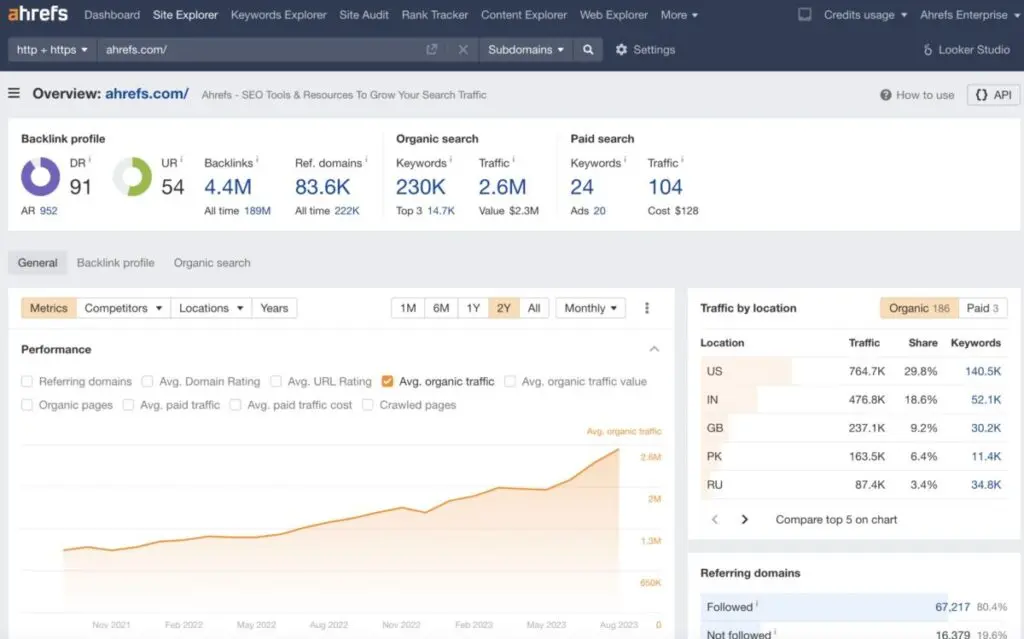When you’re trying to stand out in the digital space, having a solid marketing strategy alone isn’t going to cut it. You need to see what you’re up against so you can come up with a plan to do even better. That’s where a digital marketing competitor analysis comes in, providing you with valuable insights that will inform your strategy.
This post helps you understand what a digital marketing competitor analysis entails and why you need it. We also give you a detailed breakdown of the steps to perform a competitor analysis for digital marketing. Let’s take a look.
Digital Marketing Competitor Analysis: What It Is and How to Perform It:
What is a Digital Marketing Competitor Analysis?
A digital marketing competitor analysis is the process of researching your competitors in the digital landscape and analyzing their marketing strategies. It involves identifying their strengths and weaknesses to inform your own strategy as well as highlighting any gaps that you can fill.
Although there are parallels with traditional approaches to competitive analysis, competitor analysis for digital marketing involves an abundance of data that you can’t get through traditional platforms. You get to work with advanced tools that give you data and metrics from across various digital channels. This provides you with comprehensive insights that can be used to support your analysis.
Benefits of a Digital Marketing Competitor Analysis
Before we get into the practical aspects of digital marketing competitor analysis, you may be wondering why you need to conduct one in the first place. Here are some of the main ways in which your business can benefit from a digital marketing competitor analysis.
Benchmark Your Performance
You may be getting decent results overall, but how do you measure up to the competition? Your page may have jumped to number two in Google search rankings, but maybe your competitor is number one. Similarly, you may have 100,000 followers, but your competitors might have 200,000.
A competitor analysis helps you benchmark your performance against that of your competitors. So you can get an idea of whether what’s “good” to you is also good in the context of the competitive landscape. This will help you assess the need to ramp up your efforts and stay one step ahead.
Keep Up with Trends
Analyzing your digital marketing competitors can also help you identify new trends and stay on top of market changes. You can analyze what the competition is doing, how they’re engaging their audience, and what their audience is talking about to prepare for upcoming trends.
Social listening tools help you listen in on conversations to look for top trends and topics related to your industry. For example, you’ll be able to see which hashtags are gaining traction and which types of posts are gaining popularity.
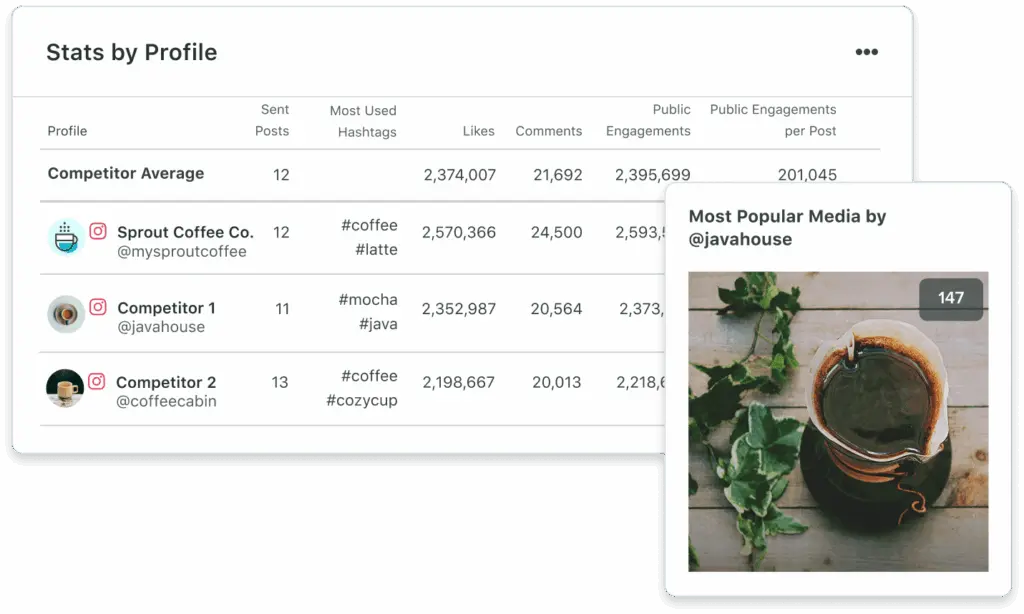
Source: sproutsocial.com
Strengthen Your Strategy
Looking into your competitors’ activities will help you understand how to improve your own strategy. This may involve experimenting with a new platform frequented by your competitors or creating a new type of content based on what’s working for them.
For example, you may have written off TikTok as a platform only for B2C brands with no relevance to a B2B audience. However, your competitor analysis reveals that a top competition is getting tons of engagement with fun and informative content on the platform. So you decide to experiment with it and add it to your own strategy.
Avoid Vital Mistakes
The best way to learn is through mistakes…or in this case, through the mistakes of the competition. A digital marketing competitor analysis lets you keep a close eye on what your competitors are doing wrong and what opportunities they’re missing. This will then help you come up with a game plan to avoid those mistakes.
Are you seeing frustrated social media comments from customers who couldn’t get a response? You’ll want to establish a customer response team to avoid this vital mistake. Are you getting plenty of 404 errors and navigation issues on their websites? You’ll want to review your own website to make sure these types of issues are addressed.
How to Perform a Digital Marketing Competitor Analysis
If the above benefits are enough to convince you to get started with digital marketing competitor analysis, let’s move on to the next steps. Here are x steps to perform a competitor analysis for digital marketing.
1. Determine Your Competitor Types
Before you can start analyzing your competitors, you have to first determine which competitors to analyze. This is one of the most crucial steps as it helps you streamline your analysis process. You can’t possibly analyze each and every business that sells the same products as you, so you have to narrow it down to some of the key competitors. That way, you can focus your efforts on the competitors that matter most.
It's also important to understand that not all competitors are the same. While some may compete directly with your brand, others may offer more complementary products. As such, they should also be treated differently. Here are the main competitor types to look out for:
- Direct Competitors – These are businesses that compete directly with your brand in that they offer similar products and target the same customer segment as you. For instance, Nike and Adidas would be considered direct competitors.

Source: footwearnews.com
- Indirect Competitors – These are businesses that sell a different type of product to the same customer segment as you. For instance, Oreo and Cheetos are indirect competitors that offer different products to consumers looking for snacks.
Categorizing your competitors will help you perform your analysis in an organized manner. You’ll be able to understand where to focus your analysis and set aside your resources accordingly. For example, while you may want to look at the keywords that your direct competitors are targeting, you may draw inspiration from the creative campaigns of indirect competitors.
2. Look into Your Competitors’ Target Audiences
Once you’ve shortlisted the competitors you want to analyze, the next step is to take a closer look at their target audiences. This can help you understand the types of people the brand is appealing to. It allows you to identify any overlaps in your audiences and even look for potential gaps in your targeting.
Moreover, analyzing your competitors’ target audiences will reveal valuable insights about how to better appeal to your own audience. Some competitor analysis tools will help you understand how your competitors’ audience spends their time, which topics they’re interested in, which platforms they use, and so on. These insights can then inform your targeting strategy and create messaging that better resonates with them.
For example, Semrush’s One2Target tool runs an analysis to show you the top domains visited by your competitor’s audience. This can inform how to plan your ad or partnership strategies to reach this audience.
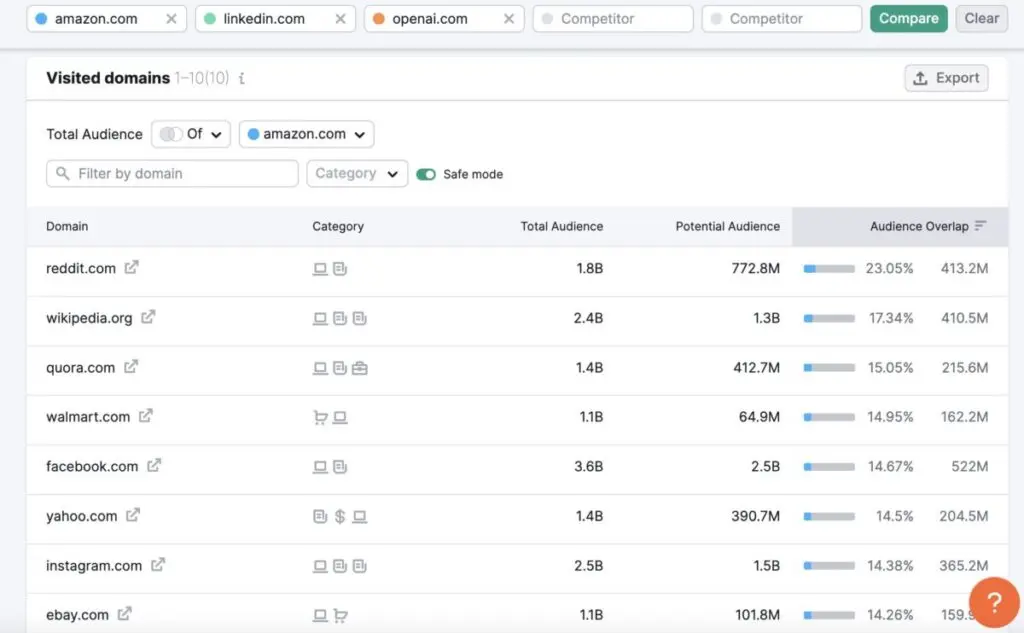
Source: semrush.com
3. Assess Their Site Performance and Rankings
A major factor that determines your competitors’ standing in the market is their place in search engine results. So this is one of the first places to start so you can assess how your site’s own performance and rankings compare to theirs. Based on this analysis, you can look for any gaps in your digital marketing strategy and identify opportunities for improvement.
Ahrefs is one of the best competitor analysis software tools to analyze site performance and rankings. It allows you to take an in-depth look into how your competitors’ URLs are performing in terms of backlinks, keywords, traffic, and referring domains.
This will give you an idea of how to strengthen your own SEO efforts and get ahead of the competition. For example, if your competitors have a strong backlink profile, you’ll want to check out their referring domains and find opportunities to earn backlinks from those websites.
4. Understand Their Traffic Acquisition Strategy
Another important question to answer is how your competitors are earning traffic. Are they investing in paid social efforts? If so, which platforms are they focusing on? Or are they mostly earning traffic through paid and organic search?
Take a closer look at your competitors’ traffic acquisition strategy so you can replicate it for your website. For instance, if they’re seeing significant traffic from email, you might want to ramp up your email marketing efforts as well.
Run a traffic analysis report using tools such as Semrush to compare traffic channels between multiple competitors. You can use this report to see which channels are sending the most traffic to your competitors’ websites.
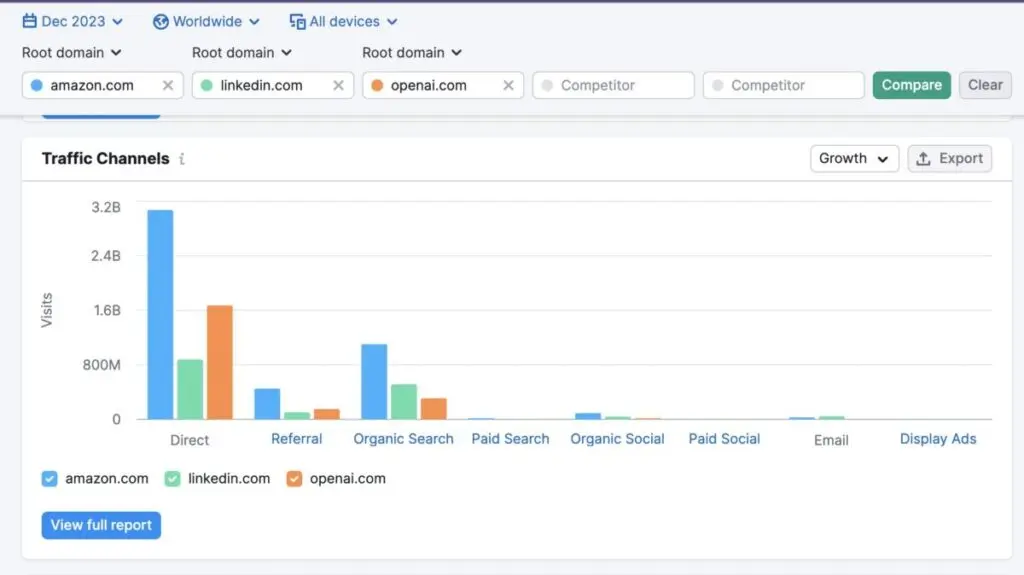
Source: semrush.com
5. Explore Their Content Marketing Efforts
The next thing to analyze about your competitors is their content marketing strategy. What types of content are they creating? Where are they distributing the content? More importantly, how are those efforts paying off?
This is a crucial step because digital marketing heavily relies on content. Understanding how your competitors are marketing their business through content will help you develop a solid content marketing strategy to compete with theirs.
Platforms like BuzzSumo are ideal for this, providing you with in-depth insights into the content performance of your competitors. You can compare multiple competitor URLs and analyze the articles on their websites to see which ones are performing the best in terms of shares and engagements. It shows you the average engagement by content types so you can understand what to focus on for your own strategy. BuzzSumo even provides data on which networks perform best and who is sharing your competitors’ content.

Source: buzzsumo.com
Through this stage of your digital competitor analysis, you should be able to optimize your strategy by understanding the following essential details:
- Which content formats you should create
- How long your articles should be
- Which networks you should use for distributing content
- Which topics you should write about
6. Research Their Paid Ads Strategy
Effective digital marketing strategies aren’t usually limited to just organic methods. Most of them have a solid paid ads strategy to complement their organic marketing efforts. So it’s important to look into where your competitors are spending they money on paid ads and how those efforts are paying off for them. This will help you understand how to better focus your spending to ensure that your ads show up on the right channels and in front of the right audience.
This stage of your competitor analysis will help you understand which terms to bid on to bring the most value for your business. It also gives you a better idea of how your competitors’ ads are performing, which will help you identify areas for improvement and create better, more impactful ads. For example, you might find a way to improve the copy to make it more enticing.
Semrush’s Advertising Research tool gives you a comprehensive look into your competitors’ advertising strategies. You can use this to see which keywords they’re bidding on, how much traffic they’re getting from those keywords, and how they’ve run ads over time. It also shows you the position earned for each ad and connects that performance with the copy they used so you know what works and what doesn’t.
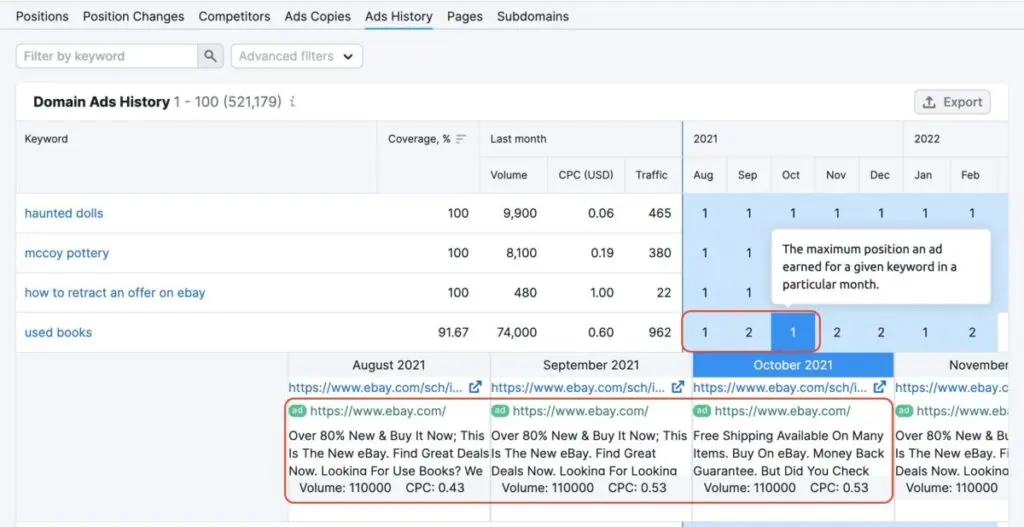
Source: semrush.com
7. Study Their Social Media Activity
Finally, you’ll want to look into your competitor’s social media activity to understand their strategy. Whether it serves as a platform for content distribution or audience engagement–social media plays a significant role in every digital marketing strategy. So it’s crucial that you pay close attention to how your competitors are leveraging it for their business.
Look into the basics such as which platforms they’re using, how many followers they have, and how active they are on each platform. Beyond this, look into the types of content they’re posting (and how often) and how much engagement they’re getting for those content types. Additionally, look at how your competitors are engaging with their audience to see if there’s anything you can replicate or improve.
This will inform your social media efforts to make better use of it for your own business. You can use a platform like Sprout Social to get a detailed competitor report and keep track of their social media performance. It helps you assess their audience growth over time and their publishing behavior, and even narrow down their top posts to see what’s working for them.

Source: support.sproutsocial.com
Stay Ahead of the Curve with a Digital Marketing Competitor Analysis
Knowing what you’re up against is the most effective way to find out how to stay ahead of the curve. It shows you what you can do better, what you should replicate, and what you should avoid. So get started with a digital marketing competitor analysis to see where your competitors are standing and how you can get ahead.
Frequently Asked Questions
What is a digital marketing competitor analysis?
A digital marketing competitor analysis is the process of researching your competitors in the digital landscape and analyzing their marketing strategies.
What is competition in digital marketing?
In digital marketing, competition refers to any business that sells the same or similar products as you and/or targets a similar audience.
Which tool is best for competitor analysis?
Depending on the type of analysis you want to run, Semrush, Ahrefs, Sprout Social, and Buzzsumo are the best tools for competitor analysis.
What are the 7 C’s of digital competitor evaluation?
The 7 C’s of digital competitor evaluation are customer, content, context, community, convenience, coherence, and conversion.
What is a competitor SWOT analysis?
A competitor SWOT analysis is a framework for evaluating your competition by analyzing strengths, weaknesses, opportunities, and threats.



